Best Vans for Van Life: Sprinter vs Transit vs Promaster
Compare the best vans for van life so you can narrow down the options that will work for you.
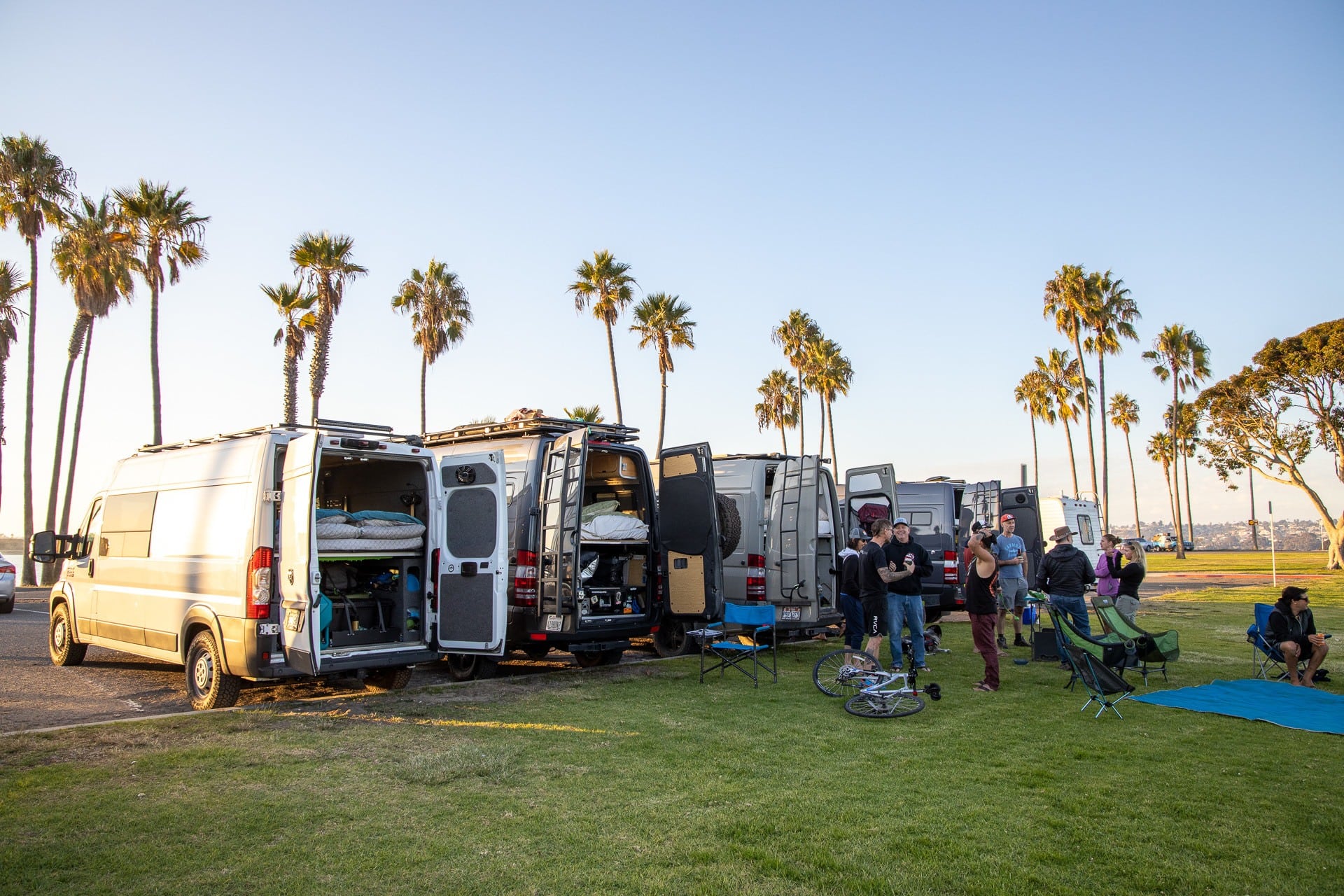
If you’re reading this blog post, chances are you’re probably wondering, “what are the best vans for van life?” There are a lot of different options out there to choose from and each van model has its own pros and cons. Whether you’re looking at a Mercedes Sprinter, Ford Transit, Dodge Promaster, or even a VW and budget-friendly cargo-style vans, there’s a lot to consider. For example, your budget, what you’ll be using the van for, and the climates you hope to travel in are just a few factors that determine what the best van will be for you.
In this post, we dive into all the details about the best vans to live in and discuss the pros and cons of the most popular vans for van life. We’ll cover budgets, off-road capability, cargo space, and more so you can narrow down the best options that will work for your lifestyle.

This post may contain affiliate links.
Sprinter Vans
As you may know, I have had two Sprinter vans. You can see my first, a 144″ Sprinter here, and my second, a 170″ Outside Van Sprinter here. My #1 reason for choosing a Sprinter over the other vehicle types is it’s currently the only one with a factory 4×4 option. We spend a lot of time in the snow and on rough dirt roads, so this was a non-negotiable for me.
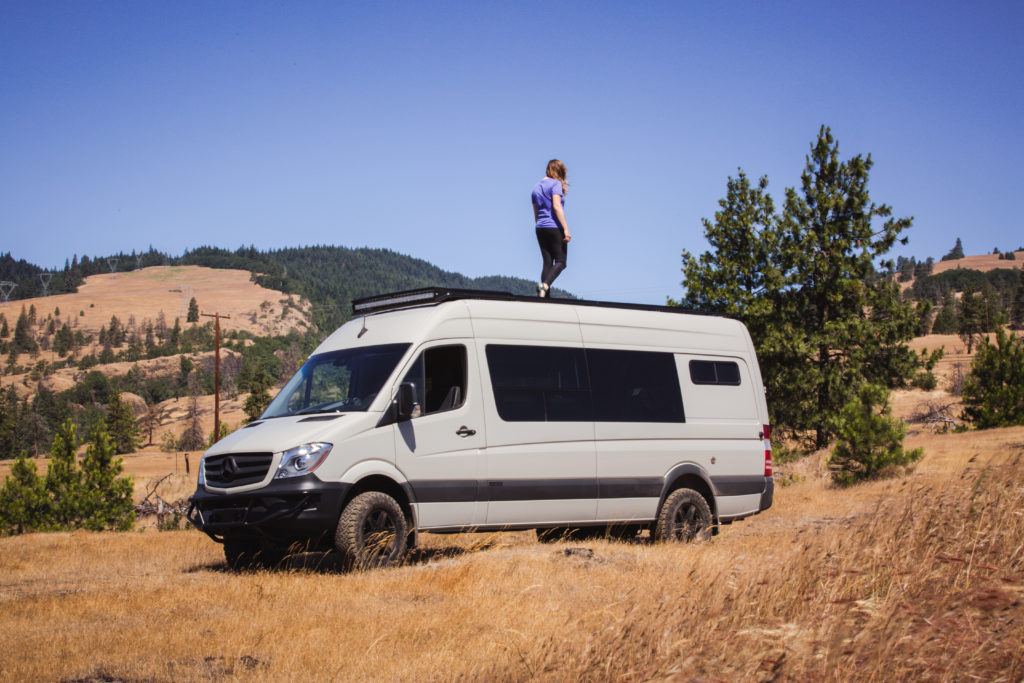
Pros and cons of Sprinter vans
Sprinter Van Pros
The Sprinter is one of the best vans for van life if it’s within your budget. Here are some of the pros of Sprinter vans:
- They get good gas mileage for a vehicle of their size (20+ mpg for the 2 wheel drive option, 13-16 mpg in the 4×4 option).
- They are available in both a 144″ and 170″ wheelbase for different size options
- They are available in diesel, which means a 400k+ mile lifetime
- Pre-2008 Sprinters don’t require diesel exhaust fluid (DEF)
- Compared to the other panel vans, Sprinters have a higher payload than the Transit or the Promaster, which means it can handle more weight in the interior of the van
- Unless you’re very tall, most people can stand up inside
Sprinter Van Cons
While I love my Sprinter and still think they are one of the best vans for van life, they do have a few cons:
- They are expensive off the bat and are expensive to maintain
- They operate on a complex computer system
- Many mechanics won’t work on them (partially because of the complex computer system), so you are stuck paying dealer prices
- They are prone to rust
Is 4×4 Worth it on the Sprinter?
Sprinters are expensive to begin with, but the 4×4 upgrade comes with an even heftier price tag and a couple of its own pros and cons to consider.
4×4 Sprinter Pros
- The Sprinter is currently one of the only van options that has a factory 4×4 option available
- The 4×4 Sprinter has a 4″ higher clearance than the standard 2 wheel drive Sprinter (and there’s even more clearance with the 2019 model)
- 4×4 Sprinters hold their value when it comes to resale
4×4 Sprinter Cons
- 4×4 Sprinters are expensive
- They are significantly less gas efficient than the 2wd version. I get about 13-16 mpg in my current Sprinter, while many 2wd V4 Sprinters are reported to get 20 miles per gallon or more
- The stock Sprinter suspension isn’t really made for off-roading, so if that’s something you want to do in your 4×4 Sprinter, you’ll likely want to consider the additional cost of a suspension upgrade
- In the past, there has been a limited supply of 4×4 Sprinters, so you may have to wait 6-9 months to get one once you place your order
If you don’t plan on off-roading or spending a lot of time in the snow, then the 2 wheel drive Sprinter should be adequate for you.
With all that said, I have been very impressed with the performance of my 4 wheel drive Sprinter and would choose to get the 4×4 upgrade if I were to get another one. For other opinions, I’ll share some links in the resources section at the end of this post for you to explore.

144 vs 170″ Sprinter Van
If you’re settled on the Sprinter van as the best van for van life, you next have to decide whether you want the 144″ or the 170″ wheelbase Sprinter.
My first Sprinter was the 144” wheelbase and my second Sprinter was the 170” wheelbase which provides about 3 1/2 extra feet of living space. There is also a 170” extended version, but that length is not very common. Here is a detailed blog post I wrote comparing and contrasting my experience with the two lengths.
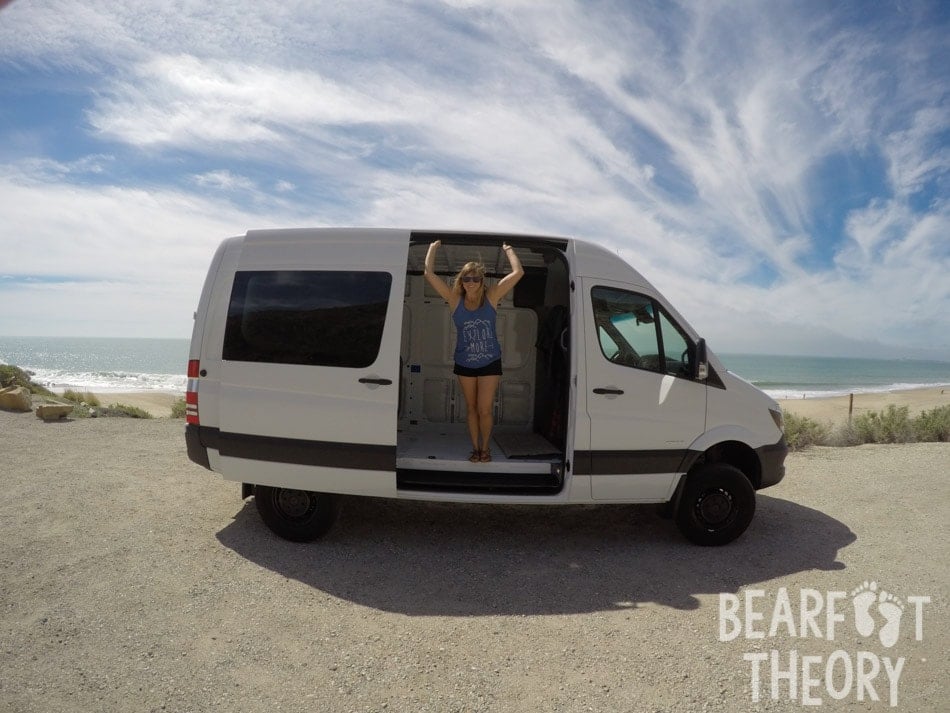
For full-time living, I have been very happy with the 170” wheelbase. The extra storage and living space have more than made up for the minor inconvenience of having a larger vehicle.
The two wheelbases are very similar in the way they drive and both are highly maneuverable. You just have to be a bit more careful with the 170” wheelbase on tight turns and steep terrain. With that said, we have rallied our 170” Sprinter all over the mountains of Colorado, and good driving skills go a long way. We also choose to avoid busy cities with crowded streets as the stress simply isn’t worth it.
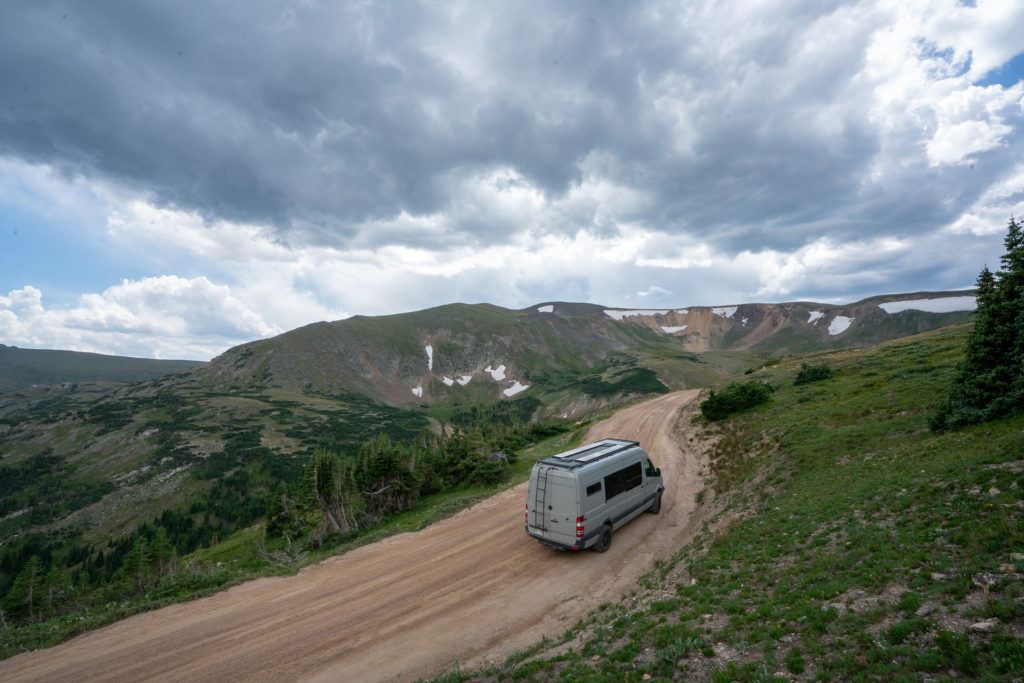
If you plan to do a lot of city driving, are only 1-2 people, and are doing van life part-time, then the 144” might be the way to go.
Sprinter van warranty
For anyone purchasing a Sprinter, I highly recommend the extended warranty. It’s expensive, but so is the maintenance. Because the computer on these Sprinters is so complicated, most regular mechanics won’t touch them, leaving the dealer as your only option when you have an issue.
Save this post!
Enter your email & I'll send this post to your inbox! You'll also receive my weekly newsletter full of helpful advice for planning your adventures.
Ford Transit Vans
For the first time in 2020, the Ford Transit came out in an all-wheel-drive version. This system is not as hearty as a traditional four-wheel drive, but it’s a big step up from the regular 2wd Transit, which is rear-wheel drive. It is less expensive than the Sprinter, but as of 2021, the all-wheel-drive Ford Transit only comes in a gas model.
The other thing to point out about the new Transit AWD is, unlike the Sprinter where the 4×4 version gets you added clearance, the Ford Transit AWD has no more clearance than the 2wd version.
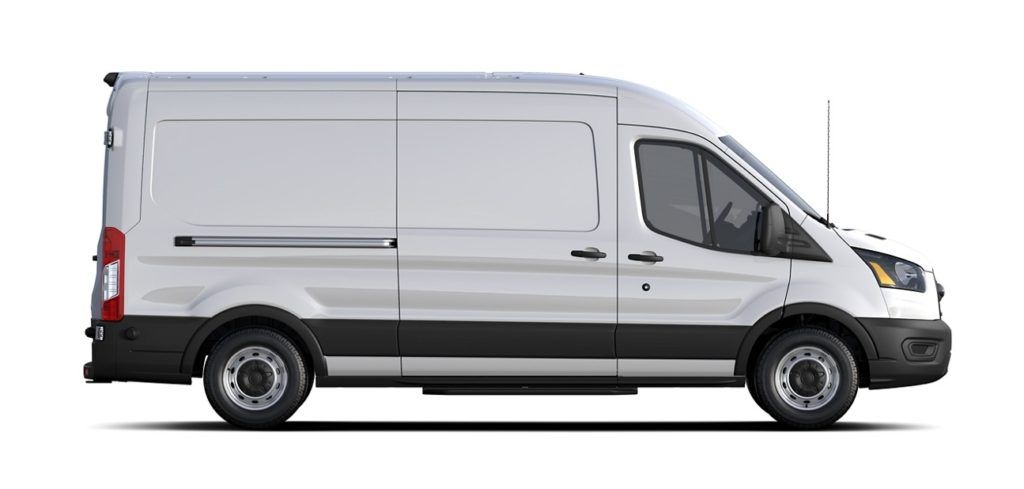
Pros and cons of the Ford Transit
Ford Transit Pros
The biggest advantages of the Ford Transit over the Sprinter are the lower cost of maintenance and the fact that you can have it serviced anywhere. Parts are easy to come by and if you break down in a small rural town, your chances of having it easily fixed (without costing a fortune) are much greater than with a Sprinter. The Ford also has the tallest interior height option for those of you over 6 feet tall.
- Ford Transits are less expensive upfront compared to Sprinters and some of the other van options for van life
- They have lower maintenance costs than Sprinters
- They are easier to service than Sprinters
- Parts are easy to come by
- They have the tallest interior height
- There is a factory all-wheel-drive option
Ford Transit Cons
- Ford Transits have lower clearance than some of the other van options out there
- The new all-wheel-drive model is only available with a gas engine, not diesel
- Ford Transits are slightly less fuel efficient compared with Sprinters
Aftermarket 4×4 Conversion
If you are set on the Ford Transit but want a more robust 4 wheel drive, you can always do an aftermarket conversion. Quigley is the leader in this space and as of 2019, their 4×4 conversion on the 2wd Transit costs about $13,000, which with the cost of the Transit van, may still be a bit cheaper than a 4×4 Sprinter depending on the options you choose
Dodge Promaster Vans
The Dodge Promaster is the most economical of the panel-style vans, so it’s a great option for those on a budget. In contrast to the 2wd Transit and Sprinter, the Promaster is front-wheel drive which provides more traction but isn’t as nimble or responsive as rear-wheel drive. You’ll notice the biggest difference when driving windy mountain roads.
The Promaster is also more DIY friendly due to its boxy nature and straight lines inside the van which make for an easier conversion.
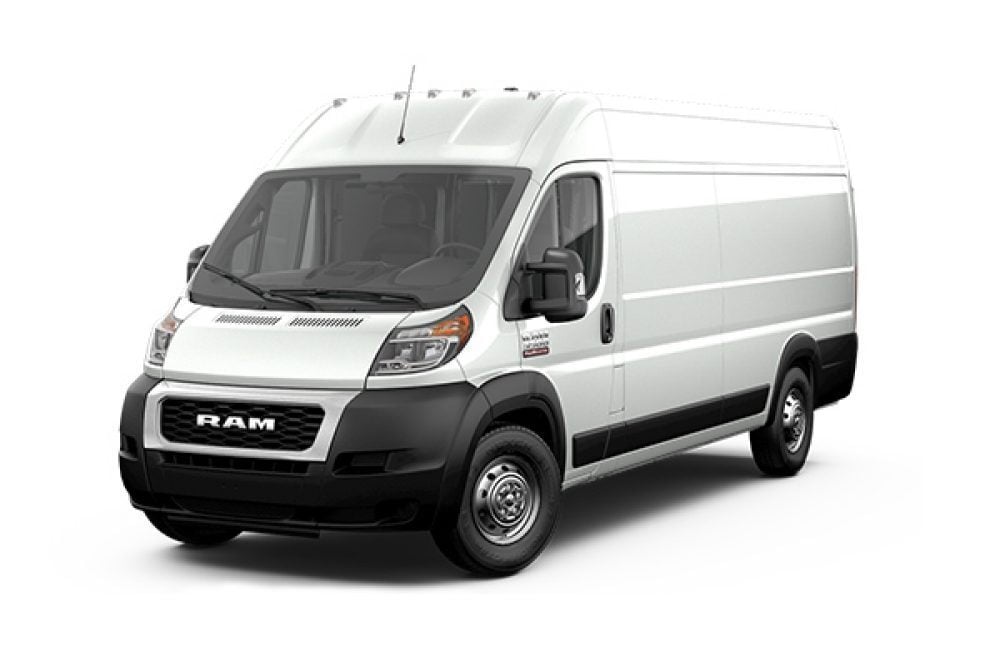
Dodge Promaster pros and cons
Dodge Promaster Pros
- Most economic of the panel style vans
- Can average about 18 miles per gallon on highways
- DIY friendly boxy shape with straight lines makes for an easier conversion
Dodge Promaster Cons
- The longest model is 3 feet shorter than the 170” Sprinter, so the Promaster will require you to pack more thoughtfully
- Ground clearance on the Promaster is 1” less than the 2wd Transit and Sprinter, so off-roading capability with the Promaster is a bit more limited
- Front wheel drive means getting stuck is more common than RWD, AWD, or 4×4 vehicles
Other Van Life Vehicle Options
Panel-style vans aren’t the only option for van life. In fact, these are relatively new to the scene, so I also want to share a few other vehicles you can consider.
Ford Econoline
If you are familiar with the van conversion company Sportsmobile, this is the vehicle platform that they traditionally used before they started converting Sprinters. The E-Series is budget-friendly with a huge used market. Some have even been converted to 4 wheel drive and these are extremely off-road capable.
The downside of the Ford E-Series is they are gas guzzlers and you cannot stand up inside unless a pop-top has been installed.
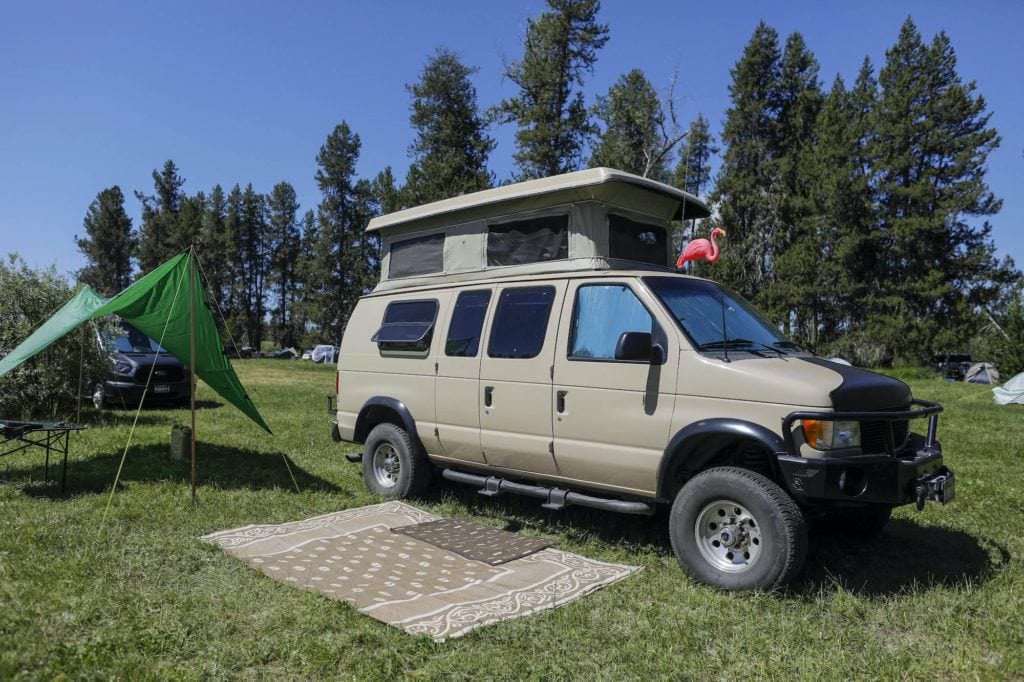
VW Vanagon / Westfalia
These vintage-style vans offer tried and tested layouts, many with a pop-top, built-in bed, and a built-in kitchen. If you choose this style of van, you better be a patient problem-solver with serious mechanical skills. Parts are hard to come by and with the age of the vehicle, you are bound to run into issues.
These vans also tend to be expensive, despite being 20, 30, and 40 years old.

While we’ve covered the most common vehicle types considered to be the best vans for van life conversions, you are really only limited by your creativity. You can create your own version of van life utilizing any type of vehicle that is big enough to sleep in. Mini-vans, truck campers, Suburbans, ambulances, hatchbacks… the list goes on. The key is to stay within your budget and make sure you have a vehicle that you will be able to maintain.
Questions to Ask Yourself When Choosing the Right Van for You
The first step for van life is choosing the right vehicle platform. What vehicle works best for one person might not be the best option for you. A surf van is different than a ski van. A family has different needs than a solo traveler. My point is there is no one size fits all solution when it comes to choosing the right vehicle for van life. Here are a few questions to ask yourself before choosing a van.

Freebie!
Evaluating Your Van Lifestyle Worksheet
Get this free PDF worksheet to help you determine your priorities for your camper van conversion.
What Is Your Budget For A Van?
Your answer to this question should guide all of your decisions moving forward. The key here is that if van life imposes too much financial stress on you, you’ll be missing the point altogether. If you really want to enjoy van life and the freedom it affords, the right vehicle for you is one that’s within your means. If you want to know more about what van life costs, check out this blog post.
Do You Want To Do Van Life Part-Time Or Full-Time And For How Long?
The reason this question is important is if you are only going to use the van on the weekends vs long-term travel, you might not need or want as extensive of a build. This can also influence the size of vehicle you’ll need for van life. If you plan on living in your van full-time, you may want a shower, a bathroom, and a bit more space. If you’re using it for traveling here and there, you might not need these things.
Where Do You Plan to Use Your Van?
If you plan to use it as a winter ski van or to travel to cold destinations, you’ll want to make sure you look for a van that you can winterize for 4 season use, or buy one that’s already outfitted this way. Or maybe you want to use your van to escape winter, and in that case, you’ll want something that’s comfortable for warmer temps, with windows that open so you can get a nice cross breeze. If you plan to rally your van on gnarly dirt roads or sand, then 4×4 may be non-negotiable. And finally, if you frequently need to go stealth in the city, then you’ll want something smaller, easier to park, and more discrete.
How Many People Will Be Living In The Vehicle?
If it’ll just be you in the van, that’s one thing, but if your partner or family is along for the ride, you’ll want to make sure they’re comfortable too. Another thing to consider is: If you’re solo now, do you think you’ll still be solo by the time you hit the road?
What Gear Is A Must For You In The Van?
Next, think about what gear is a must for you in the van. Here are some of gear I consider essential for van life. If you’re a mountain biker and you want to fit your bike inside the van, a platform bed in a panel-type van is likely what you’ll end up with. If you prefer to hike and all you need is a pack and a pair of shoes, then you might not need so much space and you’ll have a lot more layout options. In this case, you might even be able to get away with a mini-van or a hatchback.
How Tall Are You?
How tall are you? The Ford Transit has the most interior headspace, followed by the High Roof Sprinter. If you want to stand up inside your van, these and the Promaster are your best options… but again, you should let your budget do the talking. If standing up isn’t important to you, then a cargo van, like the Econoline, will be much cheaper.
When Do You Want to Start Van Life?
This is the final question. If you want to start van life as soon as possible, you’re going to be looking at used vans that are already built out. If you want a custom build, you’ll obviously need more time. Certain vans – particularly the 4×4 Sprinter and those converted by popular conversion companies – have a waitlist and could take a year to be ready.
What are your thoughts on the best vans for van life? Which model are you leaning towards for your van conversion? Leave a comment below and make sure to sign up for our van life newsletter!


Could you provide some information regarding where to find a good used van (converted) in the 25-30k price range?
Check out this blog post: https://bearfoottheory.com/buying-new-vs-used-van/
For weekend and part-time adventurers, small vans are worth considering too! The Ford Transit Connect and Ram Promaster City run on gas, get 28-30 MPG highway, handle like a car, and can squeeze into tight parking spots and parking garages like a champ. Most importantly, they can be had for less than an average crossover SUV, and are half the price of a new Sprinter. Traded my daily driver RAV4 for a Promaster City and couldn’t be happier, even if my friends think I’m a creeper for driving a white panel van 🙂
Haha, thanks for sharing that Chad! That’s a great point and those vans are great options too.
You’re brave ! the poor performance in terms of reliability of all the 3 small van offered in North America make sure that I keep my Rav4 ’13 . Fix It Again Tony = No thks . Nv200 Cvt = No thks , Transit Connect made in turkey = No Thks . It’s too bad Toyota doesn’t import the Hiace .Their new Sienna Hybrid is not a long-term solution if the batteries need to be replaced after 8 years like the all Prius.
Nice job on the comparison. My 2 cents is that one also must consider the discrepancy in the price of diesel and gas. That has to figure in to mpg. A properly cared for gas engine can easily go 400k miles, Ford F150’s are for sale all the time with 2-300k. I have owned Econolines with well over 200k that were doing just fine. I usually would buy at 80 to 100k. But my caveat when buying used is you are not really buying a vehicle you are buying the previous owners and how well the van was taken care of. Having maintenance records and or Carfax (etc.) is essential.
deck height is another consideration
the pro master with front wheel drive deck height is only 2’2″ from the ground compared with 2’9″ and 2’6″ on the transit’s high and medium roof heights and
2’7″ and 2’9″ on the sprinter’s roof heights
That’s a great point. Thank you for sharing that, Bill!
I went with a Promaster for several reasons. Longevity of diesel engines is overrated in the 21st century where gasoline engines last just as long and maintenance is easier and cheaper. I got an oil and filter change at a quick change last week for $41 for my Promaster. Ram recommends using non synthetic oils! Gasoline engines are simple by comparison and gasoline is an identical product anywhere in the world. In increasingly desperate efforts to make diesel eco-friendly complexity has been introduced into diesels along with all sorts of bio-options in the fuel itself.
Promaster has a wide enough body to take a queen sized bed sideways. Sprinter uses fiberglass pods to try to create a wide space for a sideways bed in the Revel and I don’t imagine they are insulated. Ford uses curving sides for the Transit with very thick ribs limiting interior volume and width and reducing choice of custom windows that fit the curves..
Front wheel drive makes for more room in the Promaster as has been pointed out with a lower deck height than the others. Front wheel drive helps give this van an extraordinarily tight turning radius as well.
The Promaster has been built in Mexico since 2014 using a Dodge v-6 engine identical in all models which are different only in length height and suspension. They are based on the Fiat Ducato sold world wide as Peugeot/Renault/Alfa Romeo variants suggesting they are durable and less expensive than the more fashionable models preferred by influencers. They are cargo vans and you pay extra for cruise control but they come with reversing cameras and none of the electronic driving aids are available like braking and lane control overrides on the other vans.
I have driven my 2020 van for 12 hours at a time day after day and I am 62 years old but I am 5’06” and some taller drivers complain the steering wheel is not tilt adjustable which makes for problems for the tall customers.
60 mph on cruise control gives me 18.5 mpg and 70 mph on cruise control 15 mpg fairly consistently and my 3500 EXT (21 feet long overall with maximum height) is fully built out with 600amps of lithium, 35 gallons of water, air conditioning that runs off the batteries, four solar panels and all the impedimenta of a small house.
Hope that rounds out the list with some real life experience. And Nissan is no longer selling their big van.
Thanks so much for sharing your experience! That’s super helpful. And thank you for the update on the Nissan van. Happy travels!
I just ordered the 20′ long promaster 2500 gas engine for many of the reasons you stated. I read that Nissan is going to quit making the nv but they were ready to order a custom color for me. The Dodge takes 4 months to build right now. I test drove a 2018. At 6’1″ the steering wheel does feel too high. I would think it is worse for a short person? Nissan came with more power and a couple of 120 volt inverters built in. It is too heavy and too ugly. I have 6’x12′ by 6’3″ clearance and only 20′ long. Can’t wait.
How exciting! Thanks for sharing your experience. Best of luck with your van!
I’d love to see your van and see how you designed it.
Hi Joanne – you can see the full tour of Kristen’s van at https://bearfoottheory.com/outside-van-sprinter-conversion-tour/
I’d love to see how you designed your van
It’s worth noting that the ‘4×4’ system in the Sprinter is not actually a true 4×4, it’s more like a part time AWD as it’s based on the 4Matic system by Mercedes. Ourkaravan has an excellent article that goes into many more details. Diesel quality is definitely an issue outside of N. America/ Western Europe. Modern diesel engine reliability is sadly hampered by emissions equipment, and this will especially hold true if you don’t put solid miles on the engine, as the soot will build up in the EGR.
While your requirement for a 4 x 4 limits your options, just saying the Sprinter is more expensive to maintain is quite the understatement. A fleet operator, Tom Robertson, has an in-depth editorial on Linkedin detailing the long term Sprinter maintenance costs are five times that of a Transit or Promaster. I would add, lift kits are available for the Transit and Promaster for less than $3k (installed) to address the clearance issue.
Thanks so much for sharing that. Always helpful to hear more information and different perspectives.
True! I think the psychological aspects of having to deal with a breakdown and repair situation, mid trip can influence model of van as well. I had a good friend, Sally, that traveled a few times in her new Sprinter to great hiking/camping spots, until she broke down on a small, dirt road outside of only small towns. When she finally got the tow truck there, her costs to tow to a town that could service her Sprinter was 3x’s the cost of the expensive repair. The repair was not even that big of a deal, but the computer system needed professional mechanic. This was such a bitter experience for Sally, she sold that Sprinter so fast the minute she got back home. She has since purchased a converted Transit and so far, not nearly the bitterness or fear of another breakdown that she would have if she had not sold the Sprinter. She says her trips are more enjoyable and she is willing to venture to further destinations without the worry of what the Sprinter would have brought her. I had never thought of choosing a model from this perspective. Her experience lead me to purchase the Transit as well and I am having a ball with it knowing it will need repairs down the road, but most likely not going to psychologically effect me like Sally’s situation effected her. I also added the lift kit at the time of my conversion to adjust as I need. Cost was less than $700 for product and labor install.
“If you don’t plan on off-roading or spending a lot of time in the snow”
from what i’ve seen, a converted van with lots of rear weight and the approporiate tires should fair well in snowy and icy conditions (granted probably not so well on forrest roads). @Linda, any concerns wuth 2WD if the van will be used for getting to ski destinations with maintained roads? thanks!
(search “WINTER SPRINTER VAN: Helpful Tips For Driving A 2WD Sprinter Van On Snow And Ice” on youtube for primary reference).
Hi Oliver! Apologies for the delay in getting back to you. It really depends. In some places I’m sure you could get away with 2WD on maintained roads but in Utah, for example, chains are required by law if you don’t have 4×4. If you decide to go the 2WD route and want to travel to winter destinations, you’ll definitely want good all-terrain tires and chains.
One quick question…you state that the longest Promaster is 3 ft shorter than the Sprinter 170″, but isn’t the longest Promaster 155″? Am I confusing something else? Thanks for the great comparison article!
Hey Todd, great question – the 170″ and 155″ are wheelbase lengths. The total overall van lengths have a difference of approximately three feet.
Mercedes did a great job marketing their “4×4” Sprinter; however, it’s just an AWD system with an open differential as I understand it. While I’m no fan of Ford, their AWD system seems to be a better option on paper – with available limited-slip diff and true 50/50 distribution of power. Neither one of them have low range and true locking differential – that’s where Quigley comes in, I suppose. All that being said, I’ve not had a chance to drive either in the snow or mud. Have you found yourself in many situations where you believe the Benz 4×4 system prevented a disaster? The added ground clearance is a great benefit; currently, I’m leaning towards the Transit AWD with a lift but would love to hear more about your off-road experiences!
Safety Comparison ? Only the Transit has any safety test and it’s not great (2 starts for the passenger). Gives me pause but I can’t find any information at all about the Sprinter safety. Is there other evidence to help guide toward the safest option ?
Excellent overall review. Glad that the Sprinter 4×4 is doing well so far. One thing to note – possible extremely high emission repair costs around 100-120k. See “the Fatal Flaw of Mercedes Benz Sprinters” from a fleet manager. Hopefully the situation is better now With the great MPG, 4x4ish options, and all that space it’s an enticing option if you have the money.
Many, many people boondock in GMC/Chevrolet vans. Hi-tops are not available (unless you put one on) but they are reliable, have excellent clearance and a diesel is available which provides excellent gas mileage (20-25 mpg).
Besides the atrocious clearance of the Ford Transit it also has dinky tires. I got stuck in places with one that I never got stuck with a Chevy. Clearance is poor on the Promaster and while it gets pretty good mpg, has lots of space, and is affordable that plus the front wheel drive really limits its capability off road.
“A gas engine at 150,000 miles is considered near the end of its life…” Um, I have over 300K miles on the 4.8L V8 in my Express. Still going strong. That’s not exceptional with truck engines.
Good to hear. I just went over 200K on mine. Feels as strong as the day I got it. Ditto with the transmission.
Hey Kristen, I enjoyed the article as it is very timely with the booming interest in adventure vans. I have to take exception to your comment on gas vs diesel engines however “The downside of a gas model is gas engines simply don’t last as long as diesel. A gas engine at 150,000 miles is considered near the end of its life, while diesel engines are known to run 300,000 or 400,000 miles.” In our family our GMC 5.3L and Ford 4.0L gas engines are routinely getting over 300K miles without major engine work. Additionally diesel fuel is more per gallon but the price difference has shrunk to 2.85-3.12 or $.27/gal but it still stinks and the engines are noisy. Great point about the serviceability on the Ford engines and Vans. Thanks for the research.
Thanks for that input, Michael!
Any thoughts on the Gas version of the Sprinter? My main problem with the Diesel Sprinter is high maintenance costs, long drives to capable mechanics, and I’m worried about the emissions system’s dreaded “limp mode” or 10-restart warning at inopportune locations.
Karl,
Do yourself a favor and avoid the diesel engine. It has too many issues with the emissions system. When everything’s working it’s great, but, unfortunately, when it causes problems and it will you’ll be disabled for either a short or long period of time. What’s worse is that the ad-blue tank on some of the Sprinters is under the chassis and in order to get to this part Mercedes Benz will require that you remove a significant amount of the plumbing just to gain access to the components. I’ve been dealing with a situation where they say “yeah, it’s under warranty and a covered item, but, we want you to have the entire system dismantled before we’ll even touch it. Some of this involves taking apart one of the vent pipes that’s attached to the toilet and glued or welded on. This is outrageous. It’s their way of denying you the work. Please do NOT purchase a Mercedes Sprinter upfitted van that’s a motorhome.
HI I don’t normally comment but on the comparative diesel engine life and modern gas engine life is simply not true ! I am a retired fleet mechanic and have a world class ASE certification and have maintained large fleets of gas engine pickups in the oil field and mines .nothing is harder on trucks or vans then this environment .Good maintenance is key .I worked at one oil field service shop that when I left we had Ford ,Dodge and Chevy pickups with gas v8s all with over 350 k mile that looked like hell ,doors didn’t shut right ,beat up from abuse and I would have trusted them to get me any were ,and none had more than minor engine work like a water pump , tune up ,alternator .O by the way i own a 2007 fright liner sprinter with the 3.0 Mercedes diesel .Easiest engine To change oil It took me less than 45 min the first time I touched one and some dealer want up 400 plus for a 10k mile service .that is just plain price gouging to fatten up dealers .The true reason non sprinter dealers mechanics wont work on them is not complexity all modern vehicles are like rocket science struggling to meet EPA. and CAFE standards .German built vehicles since 2010 has chosen not to share information on there vehicles .Why simply put to make more money for the dealer.Think i am exaggerating? look at a owners Manuel for example for a 2014 WV Jetta and it wont even tell you what the fuses are for .there is much more to it but manufacturers for autos and many other products are pushing laws to make it impossible for self repairs and independent shops to compete. Thank you for your web site Howard
Thanks for sharing your professional insights, Howard!
No, no and no! None of the above. Once again, the Chevy Express/GMC Savana gets no love despite the fact that they’re reliable as hell and, using aftermarket parts, are, with the Econoline, easily the most offroad ready. No to the Sprinter despite its wonderful size – too darn expensive and too darn uncertain regarding reliability; no to the Transit – too little clearance requiring massive suspension changes that I’m not sure should be be done to any vehicle; plus it’s a unibody; and no to the Promaster because of its front-wheel drive and inability to get 4wd.
That the leaves the Chevy/GMC vans – no hi-top (sucks!), gas mileage is not great (but getting better with the 6.6 and probably now on par with the Transit), old, old Chassis (it works :)), not many goodies (no touch screen), and less cargo space (that does suck, I must say) but a reliable, better driving vehicle than the Econoline, that you can buy new, and get 4wd, a rear locker, a lift, etc.. and it has enough grunt to pull a nice trailer behind it (bye-bye Transit and most Sprinters). So, for me – someone who gets offroad and into the backcountry a lot – the Chevy/GMC is the choice right now. If the Transit comes out with 4×4, better clearance, and towing capability, it will be the choice. – but not yet.
Do your homework guys – lots of Chevy vans out there.
VW Crafter is not available in the US? Or is there other reasons not to consider it as a good option? I live in Mexico and I am currently trying to decide whether to buy a Sprinter or a Crafter. I found this last one as a very good option, as is the same size as 170 sprinter, almost the same price, but upfront costs are cheaper (maintenance). Any comments on the Crafter? Thanks
Hi Francisco, we haven’t seen this in the US or know anyone with a VW Crafter so can’t comment on whether it’s a good option or not. One thing to keep in mind if you plan to drive it in the US is to research how easy it is to find mechanics that can work on a Crafter. Kristen has owned 2 Sprinters (and is building out a 3rd), so we definitely recommend Sprinters and have a lot of resources on the blog about them, if that’s the route you choose. Good luck with your van search!
Thanks for all this information about the situation in the USA. Living in England I am at the lowest end of campervans – a micro campervan – as it is based on a Fiat Qubo – just under 4m in international units! I have owned campervans for just over 50 years starting with a VW Wesfalia van. As a now single retiree with limited funds my ‘van is ideal for me. It can go anywhere easily as it is under 2m tall so height barriers and multi storey car parks are no impediment. However it expands when camping with a rising roof and importantly a tent which fits over the hatchback and only two tent poles required. All mod cons are there – radio/cd player, tv/dvd player, eberspaecher diesel space heater plus all the usual necessities. I don’t have everything I want but I have everything I need! Wishing you all the best!
Hi Philip, 50 years of owning campervans — wow! That’s inspiring & I’m sure full of wonderful memories and adventures. You bring up a great point that the ideal van is what is ideal for YOU, and that looks different for everyone. Sounds like you have a great fit for this season of life with the micro-van. Thanks for sharing about your experience in England! Safe travels.
I found it interesting when you informed us that Sprinter vans have good gas mileage, so they are quite ideal as a van option. It seems like my brother invested in a Sprinter van for his delivery service recently. I hope he finds a good load board to put the van’s good mileage to better use soon for his business. https://myvirtualfleet.com/cargo-vans/
Any other companies you can susggest that build Ford Transit vans?
Thank you
Hi Maureen – unfortunately I don’t have personal experience with any companies that are currently building out transits, so I hesitate to make any recommendations. I’d get on the sprinter forum or the expedition portal forum and see if anyone over there has recommendations.
We built our Sprinter camper in 2016, and still like it for its good handling and fuel economy (we get low 20s mpg on the interstate, occasionally 25 mpg on secondary roads). Not that expensive to buy; we got our 2014 used (38k miles) for $30k, though they have increased in price since. The year we bought our 2014 we could have bought a new 2016 for $38k; this year I saw one on our dealer’s lot for $51k.
You’re dead on about the maintenance. Not many shops work on Sprinters, and dealer service departments tend to be expensive. Parts are pricey as well – if you can find a shop in that rural location you broke down. That might be the one reason I’d consider moving to a Transit build. Countering that: the middle-roof Transit option is a couple inches too short for me to stand up inside, while the high-roof is waaay tall. A high-roof Sprinter is just tall enough inside for me to stand up straight.
We got ours before 4WD was available. As we mostly operate spring/summer/autumn we haven’t minded 2WD. Going to mud/snow tires helped traction a lot. We’ve even driven in the snow without worry, though not a LOT of snow. If we were serious about using the van in winter we’d probably spring for a 4WD and build out that.